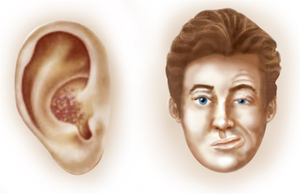Ramsay Hunt syndrome type II
| Ramsay Hunt syndrome (RHS) type 2 | |
|---|---|
 |
|
| Classification and external resources | |
| Specialty | infectious disease |
| ICD-10 | B02.2 (ILDS B02.270), G53.0 |
| ICD-9-CM | 053.11 |
| DiseasesDB | 11176 |
| MedlinePlus | 001647 |
| eMedicine | neuro/420 |
| MeSH | D016697 |
Ramsay Hunt syndrome type 2, also known as herpes zoster oticus, is a disorder that is caused by the reactivation of varicella zoster virus in the geniculate ganglion, a nerve cell bundle of the facial nerve.
Ramsay Hunt syndrome type 2 typically presents with inability to move many facial muscles, pain in the ear, taste loss on the front of the tongue, dry eyes and mouth, and a vesicular rash.
The symptoms and signs include acute facial nerve paralysis, pain in the ear, taste loss in the front two-thirds of the tongue, dry mouth and eyes, and an erythematous vesicular rash in the ear canal, the tongue, and/or hard palate.
Since the vestibulocochlear nerve is in proximity to the geniculate ganglion, it may also be affected, and patients may also suffer from tinnitus, hearing loss, and vertigo. Involvement of the trigeminal nerve can cause numbness of the face.
Ramsay Hunt syndrome type 2 refers to shingles of the geniculate ganglion. After initial infection, varicella zoster virus lies dormant in nerve cells in the body, where it is kept in check by the immune system. Given the opportunity, for example during an illness that suppresses the immune system, the virus travels to the end of the nerve cell, where it causes the symptoms described above.
The affected ganglion is responsible for the movements of facial muscles, the touch sensation of a part of ear and ear canal, the taste function of the frontal two-thirds of the tongue, and the moisturization of the eyes and the mouth. The syndrome specifically refers to the combination of this entity with weakness of the muscles activated by the facial nerve. In isolation, the latter is called Bell's Palsy.
...
Wikipedia
